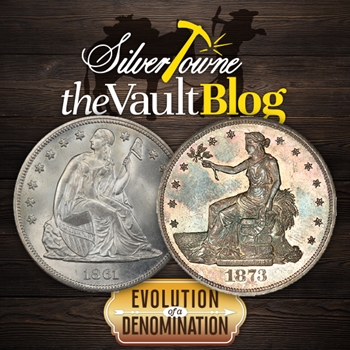
Amidst an economic depression in a time coined the “Hard Times,” President Andrew Jackson was taking on the Van Buren Administration’s faith in hard money in 1840. Hard money, namely silver and gold, was the only reliable value in comparison to paper money, which was deemed worthless, and credit which was less than secure. The United States Mint wanted to tackle the hard money direction, hoping to produce a new silver dollar for circulation.
Liberty Seated (1840-1873)
Mint Director Robert Patterson was a fan of Britannia. He thought that the image of a seated female figure was just as symbolic of liberty as those heads and busts of the already produced United States coinage. He commissioned painter Thomas Sully to make sketches of a seated Liberty. She would end up perched on a rock in Grecian robes while holding a Union shield with a scroll inscribed with “LIBERTY” on her left arm. Her right arm holds a pole topped with a small Liberty Cap. Christian Gobrecht, the Mint’s assistant engraver, would adapt the sketches to bas-relief more applicable for coinage. The sketch would end up at one time or another on other denominations including half dimes, 20-cent pieces, dimes, quarters, half dollars, and dollars from 1836 to 1891.
While the obverse of Liberty was adopted, the flying eagle design for the reverse was rejected. The “No Motto” silver dollar (1840-1865) featured a bird with dropped wings and a shield on its breast. Liberty had just 13 stars surrounding her on the obverse with the date below. The coins did not have the motto “IN GOD WE TRUST” on the reverse. The first year of issue saw 61,005 coins produced.
The Liberty Seated design would gain the motto back in 1866 and last until 1873. Secretary of the Treasury Salmon P. Chase would write a letter to James Pollock, then Director of the United States Mint, that stated the following: “The trust of our people in God should be declared on our national coins. You will cause a device to be prepared without unnecessary delay with a motto expressing in the fewest and tersest terms possible this national recognition.”
In February of 1873, Congress passed the Coinage Act known as “The Crime of ‘73.” It would demonetize silver and put the nation on a gold standard. It would abolish the regular issue of the silver dollar along with the two-cent piece and the half dime.
Trade Dollar (1873-1885)
With the large quantities of silver being mined from the Comstock Lode and other mines in the West, the government would face a quandary. Limited coins were being used and silver coins were few and far between in circulation after wartime hoarding and as a result of the new gold standard imposed on the nation. However, they were also nervous about new silver coins being hoarded as well as paper money was circulating the market much more. While the miners would find outlets for their silver in foreign markets for a time, including Canada, Latin America, and Europe, those markets would eventually become congested for a variety of reasons.
This became increasingly worrisome with the miners and their allies in Washington, D.C. It became hard to sell their silver and the market was declining. While the United States was not producing silver coinage, there was one law that made it possible for the Mint to take in deposited silver and convert it into silver coins for exchange purposes only. Miners used this outlet to get rid of their stock and they chose silver dollars to do it. Silver dollar mintages exceeded one million in both 1871 and 1872. The Coinage Act of 1873, however, would come into effect and suspend any more production of silver dollars. Enter the Trade dollar.
Mining interests got approval for the new Trade dollar as it would help ease the problem with securing an outlet for their silver. In addition, it would also create a new market for them. That market was Asia, more specifically China. The Chinese preferred silver coins and up until that point, American trade with them had been done with Spanish and Mexican dollars. The Trade dollar would supply them with a coin higher in silver content, saying right on them “420 GRAINS, 900 FINE.” The design looked similar to the Liberty Seated dollar with its seated female figure symbolizing Liberty on the obverse and an eagle on the reverse. The designs were done by Chief Engraver William Barber.
Over 27 million dollars went overseas and were used within Asian commerce. Many would end up in India as a trade for opium and some would show chop marks (Chinese symbols) used by merchants to authorize their authenticity. However, problems with the Trade dollar started occurring on American soil when Congress decided to make the coin legal tender for domestic spending up to five dollars. By 1876, millions were circulating into the nation’s coinage and when silver prices dropped, they were worth more as money than as metal. Their legal tender status would quickly be revoked causing more trouble than it was worth. This would ultimately lead to their downfall with production finally being suspended in 1878 except for Proofs which would continue until 1885.
NGC Coin; The Official 2023 Red Book







